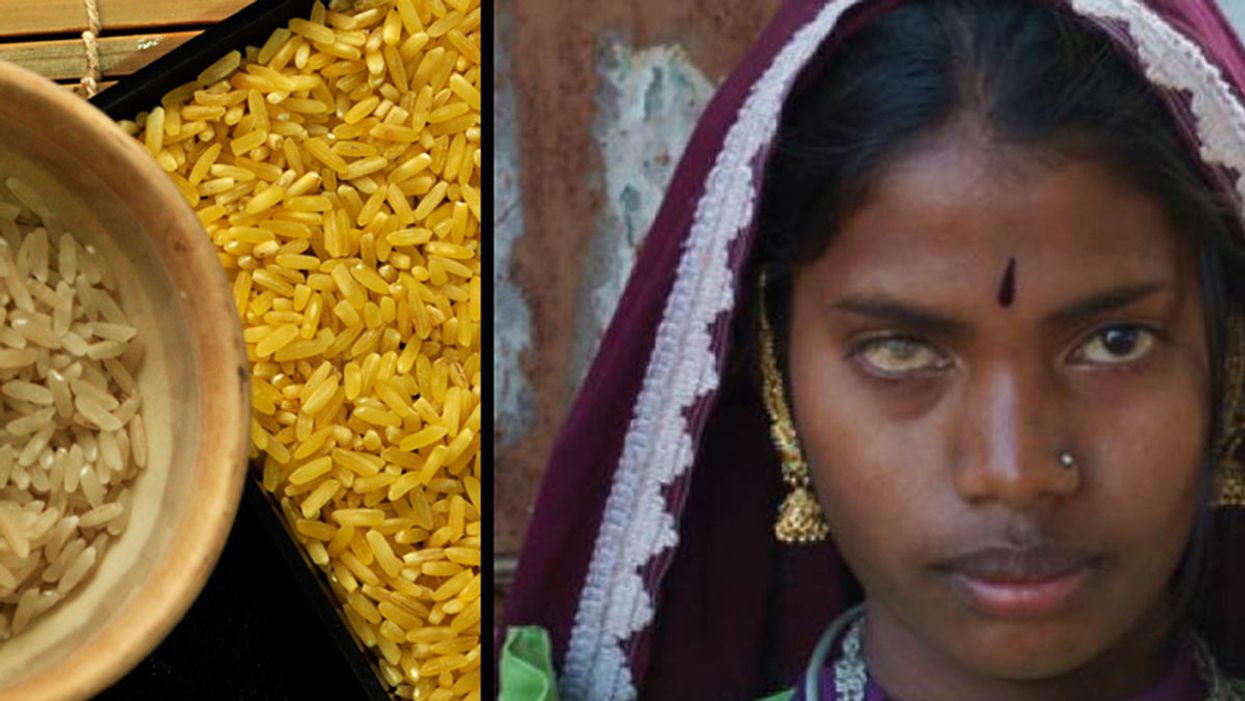We Pioneered a Technology to Save Millions of Poor Children, But a Worldwide Smear Campaign Has Blocked It

On left, a picture of white rice next to Golden Rice, and on right, a girl who lost one eye due to vitamin A deficiency.
In a few weeks it will be 20 years that we three have been working together. Our project has been independently praised as one of the most influential of all projects of the last 50 years.
Two of us figured out how to make rice produce a source of vitamin A, and the rice becomes a golden color instead of white.
The project's objectives have been admired by some and vilified by others. It has directly involved teams of highly motivated people from a handful of nations, from both the private and public sector. A book, dedicated to the three of us, has been written about our work. Nevertheless, success has, so far, eluded us all. The story of our thwarted efforts is a tragedy that we hope will soon – finally – reach a milestone of potentially profound significance for humanity.
So, what have we been working on, and why haven't we succeeded yet?
Food: everybody needs it, and many are fortunate enough to have enough, even too much of it. Food is a highly emotional subject on every continent and in every culture. For a healthy life our food has to provide energy, as well as, in very small amounts, minerals and vitamins. A varied diet, easily achieved and common in industrialised countries, provides everything.
But poor people in countries where rice is grown often eat little else. White rice only provides energy: no minerals or vitamins. And the lack of one of the vitamins, vitamin A, is responsible for killing around 4,500 poor children every day. Lack of vitamin A is the biggest killer of children, and also the main cause of irreversible childhood blindness.
Our project is about fixing this one dietary deficiency – vitamin A – in this one crop – rice – for this one group of people. It is a huge group though: half of the world's population live by eating a lot of rice every day. Two of us (PB & IP) figured out how to make rice produce a source of vitamin A, and the rice becomes a golden color instead of white. The source is beta-carotene, which the human body converts to vitamin A. Beta-carotene is what makes carrots orange. Our rice is called "Golden Rice."
The technology has been donated to assist those rice eaters who suffer from vitamin A deficiency ('VAD') so that Golden Rice will cost no more than white rice, there will be no restrictions on the small farmers who grow it, and nothing extra to pay for the additional nutrition. Very small amounts of beta-carotene will contribute to alleviation of VAD, and even the earliest version of Golden Rice – which had smaller amounts than today's Golden Rice - would have helped. So far, though, no small farmer has been allowed to grow it. What happened?
To create Golden Rice, it was necessary to precisely add two genes to the 30,000 genes normally present in rice plants. One of the genes is from maize, also known as corn, and the other from a commonly eaten soil bacterium. The only difference from white rice is that Golden Rice contains beta-carotene.
It has been proven to be safe to man and the environment, and consumption of only small quantities of Golden Rice will combat VAD, with no chance of overdosing. All current Golden Rice results from one introduction of these two genes in 2004. But the use of that method – once, 15 years ago - means that Golden Rice is a 'GMO' ('genetically modified organism'). The enzymes used in the manufacture of bread, cheese, beer and wine, and the insulin which diabetics take to keep them alive, are all made from GMOs too.
The first GMO crops were created by agri-business companies. Suspicion of the technology and suspicion of commercial motivations merged, only for crop (but not enzymes or pharmaceutical) applications of GMO technology. Activists motivated by these suspicions were successful in getting the 'precautionary principle' incorporated in an international treaty which has been ratified by 166 countries and the European Union – The Cartagena Protocol.
The equivalent of 13 jumbo jets full of children crashes into the ground every day and kills them all, because of vitamin A deficiency.
This protocol is the basis of national rules governing the introduction of GMO crops in every signatory country. Government regulators in, and for, each country must agree before a GMO crop can be 'registered' to be allowed to be used by the public in that country. Currently regulatory decisions to allow Golden Rice release are being considered in Bangladesh and the Philippines.
The Cartagena Protocol obliges the regulators in each country to consider all possible risks, and to take no account of any possible benefits. Because the anti-gmo-activists' initial concerns were principally about the environment, the responsibility for governments' regulation for GMO crops – even for Golden Rice, a public health project delivered through agriculture – usually rests with the Ministry of the Environment, not the Ministry of Health or the Ministry of Agriculture.
Activists discovered, before Golden Rice was created, that inducing fear of GMO food crops from 'multinational agribusinesses' was very good for generating donations from a public that was largely illiterate about food technology and production. And this source of emotionally charged donations would cease if Golden Rice was proven to save sight and lives, because Golden Rice represented the opposite of all the tropes used in anti-GMO campaigns.
Golden Rice is created to deliver a consumer benefit, it is not for profit – to multinational agribusiness or anyone else; the technology originated in the public sector and is being delivered through the public sector. It is entirely altruistic in its motivations; which activists find impossible to accept. So, the activists believed, suspicion against Golden Rice had to be amplified, Golden Rice had to be stopped: "If we lose the Golden Rice battle, we lose the GMO war."
Activism continues to this day. And any Environment Ministry, with no responsibility for public health or agriculture, and of course an interest in avoiding controversy about its regulatory decisions, is vulnerable to such activism.
The anti-GMO crop campaigns, and especially anti-Golden Rice campaigns, have been extraordinarily effective. If so much regulation by governments is required, surely there must be something to be suspicious about: 'There is no smoke without fire'. The suspicion pervades research institutions and universities, the publishers of scientific journals and The World Health Organisation, and UNICEF: even the most scientifically literate are fearful of entanglement in activist-stoked public controversy.
The equivalent of 13 jumbo jets full of children crashes into the ground every day and kills them all, because of VAD. Yet the solution of Golden Rice, developed by national scientists in the counties where VAD is endemic, is ignored because of fear of controversy, and because poor children's deaths can be ignored without controversy.
Perhaps more controversy lies in not taking scientifically based regulatory decisions than in taking them.
The tide is turning, however. 151 Nobel Laureates, a very significant proportion of all Nobel Laureates, have called on the UN, governments of the world, and Greenpeace to cease their unfounded vilification of GMO crops in general and Golden Rice in particular. A recent Golden Rice article commented, "What shocks me is that some activists continue to misrepresent the truth about the rice. The cynic in me expects profit-driven multinationals to behave unethically, but I want to think that those voluntarily campaigning on issues they care about have higher standards."
The recently published book has exposed the frustrating saga in simple detail. And the publicity from all the above is perhaps starting to change the balance of where controversy lies. Perhaps more controversy lies in not taking scientifically based regulatory decisions than in taking them.
But until they are taken, while there continues a chance of frustrating the objectives of the Golden Rice project, the antagonism will continue. And despite a solution so close at hand, VAD-induced death and blindness, and the misery of affected families, will continue also.
© The Authors 2019. This article is distributed under the terms of the Creative Commons Attribution 4.0 International License, which permits unrestricted use, distribution, and reproduction in any medium, provided you give appropriate credit to the original author(s) and the source, provide a link to the Creative Commons license, and indicate if changes were made. The Creative Commons Public Domain Dedication waiver applies to the data made available in this article, unless otherwise stated.
Saliva May Help Diagnose PTSD in Veterans
A recent study finds that former soldiers with post traumatic stress disorders have a certain set of bacteria in their saliva, a distinct signature that is believed to be the first biological marker for PTSD.
As a bioinformatician and young veteran, Guy Shapira welcomed the opportunity to help with conducting a study to determine if saliva can reveal if war veterans have post-traumatic stress disorder, or PTSD.
The research team, which drew mostly from Tel Aviv University’s Sackler Faculty of Medicine and Sagol School of Neuroscience, collected saliva samples from approximately 200 veterans who suffered psychological trauma stemming from the years they spent fighting in the First Lebanon War in 1982. The researchers also characterized the participants’ psychological, social and medical conditions, including a detailed analysis of their microbiomes.
They found that the former soldiers with PTSD have a certain set of bacteria in their saliva, a distinct microbiotic signature that is believed to be the first biological marker for PTSD. The finding suggests that, in the future, saliva tests could be used to help identify this disorder. As of now, PTSD is often challenging to diagnose.
Shapira, a Ph.D. student at Tel Aviv University, was responsible for examining genetic and health-related data of the veterans who participated – information that had been compiled steadily over four decades. The veterans provided this data voluntarily, Shapira says, at least partly because the study carries important implications for their own psychological health.
The research was led by Illana Gozes, professor emerita of clinical biochemistry. “We looked at the bacteria in their blood and their saliva,” Gozes explains. To discover the microbial signatures, they analyzed the biometric data for each soldier individually and as a group. Comparing the results of the participants’ microbial distribution to the results of their psychological examinations and their responses to personal welfare questionnaires, the researchers learned that veterans with PTSD – and, more generally, those with significant mental health issues – have the same bacterial content in their saliva.
“Having empirical metrics to assess whether or not someone has PTSD can help veterans who make their case to the Army to get reparations,” Shapira says.
More research is required to support this finding, published in July in Nature’s prestigious Molecular Psychiatry, but it could have important implications for identifying people with PTSD. Currently, it can be diagnosed only through psychological and behavioral symptoms such as flashbacks, nightmares, sleep disorders, increased irritability and physical aggressiveness. Veterans sometimes don’t report these symptoms to health providers or realize they’re related to the trauma they experienced during combat.
The researchers also identified a correlation that indicates people with a higher level of education show a lower occurrence of the microbiotic signature linked to PTSD, while people who experienced greater exposure to air pollution show a higher occurrence of this signature. That confirms their finding that the veterans’ health is dependent on their individual biology combined with the conditions of their environment.
“Thanks to this study, it may be possible in the future to use objective molecular and biological characteristics to distinguish PTSD sufferers, taking into account environmental influences,” Gozes said in an article in Israel21c. “We hope that this new discovery and the microbial signatures described in this study might promote easier diagnosis of post-traumatic stress in soldiers so they can receive appropriate treatment.”
Gozes added that roughly a third of the subjects in their study hadn’t been diagnosed with PTSD previously. That meant they had never received any support from Israel’s Ministry of Defense or other officials for treatment and reparations, the payments to compensate for injuries sustained during war.
Shapira’s motivation to participate in this study is personal as well as professional: in addition to being veteran himself, his father served in the First Lebanon War. “Fortunately, he did not develop any PTSD, despite being shot in the foot...some of his friends died, so it wasn’t easy on him,” says Shapira.
“Having empirical metrics to assess whether or not someone has PTSD can help veterans who make their case to the Army to get reparations,” Shapira says. “It is a very difficult and demanding process, so the more empirical metrics we have to assess PTSD, the less people will have to suffer in these committees and unending examinations that are mostly pitched against the veterans because the state is trying to avoid spending too much money.”
The Friday Five Weekly Roundup in Health Research
In this week's Friday Five, the right facial expression for your mental health. Plus, can virtual reality reduce pain? Lab made blood vessels. Gene editing muscles to lower blood sugar. And a magic ingredient coming from exhaust vents.
The Friday Five covers five stories in research that you may have missed this week. There are plenty of controversies and troubling ethical issues in science – and we get into many of them in our online magazine – but this news roundup focuses on scientific creativity and progress to give you a therapeutic dose of inspiration headed into the weekend.
Listen on Apple | Listen on Spotify | Listen on Stitcher | Listen on Amazon | Listen on Google
Here are the promising studies covered in this week's Friday Five:
- The right facial expression for your mental health
- Can virtual reality reduce pain?
- Lab made blood vessels
- Gene editing muscles to lower blood sugar
- A magic ingredient coming from exhaust vents

